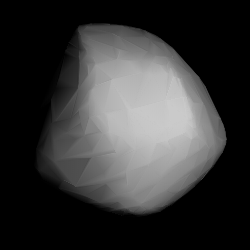Astronomy:46 Hestia
 3D convex shape model of 46 Hestia | |
| Discovery | |
|---|---|
| Discovered by | Norman Robert Pogson |
| Discovery date | August 16, 1857 |
| Designations | |
| (46) Hestia | |
| Pronunciation | /ˈhɛstiə/[1] |
| Named after | Hestia |
| Minor planet category | main belt |
| Orbital characteristics[2] | |
| Epoch December 31, 2006 (JD 2454100.5) | |
| |{{{apsis}}}|helion}} | 2.961 AU (442.886 Gm) |
| |{{{apsis}}}|helion}} | 2.091 AU (312.736 Gm) |
| 2.526 AU (377.811 Gm) | |
| Eccentricity | 0.172 |
| Orbital period | 4.01 a (1465.958 d) |
| Mean anomaly | 45.401° |
| Inclination | 2.342° |
| Longitude of ascending node | 181.168° |
| 176.882° | |
| Physical characteristics | |
| Dimensions | 124.1 km[2] |
| Mass | 3.5×1018 kg[3] |
| Mean density | 5.81 ± 0.87[4] g/cm3 |
| Rotation period | 21.04[5] h |
| Geometric albedo | 0.052[2] |
| C | |
| Absolute magnitude (H) | 8.36[2] |
Hestia (minor planet designation: 46 Hestia) is a large, dark main-belt asteroid. It is also the primary body of the Hestia clump, a group of asteroids with similar orbits.
Hestia was discovered by N. R. Pogson on August 16, 1857, at the Radcliffe Observatory, Oxford. Pogson awarded the honour of naming it to William Henry Smyth, the previous owner of the telescope used for the discovery. Smyth chose to name it after Hestia, Greek goddess of the hearth.[6] This created a problem in Greek, where 4 Vesta also goes by the name Hestia.
The computed Lyapunov time for this asteroid is 30,000 years, indicating that it occupies a chaotic orbit that will change randomly over time because of gravitational perturbations of the planets.[7]
Hestia has been studied by radar.[8] 13-cm radar observations of this asteroid from the Arecibo Observatory between 1980 and 1985 were used to produce a diameter estimate of 131 km.[9] In 1988 a search for satellites or dust orbiting this asteroid was performed using the UH88 telescope at the Mauna Kea Observatories, but the effort came up empty.[10]
Properties
Photometric observations made in 2012 at the Organ Mesa Observatory in Las Cruces, New Mexico produced a light curve with a period of 21.040 ± 0.001 hours. There are two brightness minima, having luminosity variations of 0.05 and 0.12 in magnitude, respectively.[5]
In 2000, Michalak estimated Hestia to have a mass of 3.5×1018 kg.[3][11]
Even though Hestia is only about 124 km in diameter,[2] in 1997, Bange and Bec-Borsenberger estimated Hestia as having a mass of 2.1×1019 kg, based on a perturbation by 19 Fortuna.[12][13][14] This older 1997 estimate would give it a density of 14+ g/cm3[12] and make Hestia more massive than several much larger asteroids.
References
- ↑ "Hestia". Dictionary.com Unabridged. Random House. https://www.dictionary.com/browse/Hestia.
- ↑ 2.0 2.1 2.2 2.3 2.4 Yeomans, Donald K.. "JPL Small-Body Database Browser: 46 Hestia". https://ssd.jpl.nasa.gov/sbdb.cgi?sstr=46.
- ↑ 3.0 3.1 Michalak, G. (2001). "Determination of asteroid masses". Astronomy & Astrophysics 374 (2): 703–711. doi:10.1051/0004-6361:20010731. Bibcode: 2001A&A...374..703M.
- ↑ Carry, B. (December 2012), "Density of asteroids", Planetary and Space Science 73 (1): 98–118, doi:10.1016/j.pss.2012.03.009, Bibcode: 2012P&SS...73...98C. See Table 1.
- ↑ 5.0 5.1 Pilcher, Frederick (July 2012). "Rotation Period Determinations for 46 Hestia, 223 Rosa, 225 Henrietta, 266 Aline, 750 Oskar, and 765 Mattiaca". The Minor Planet Bulletin 39 (3): 171–173. Bibcode: 2012MPBu...39..171P.
- ↑ Schmadel, Lutz (2003). Dictionary of minor planet names (fifth ed.). Germany: Springer. p. 19. ISBN 3-540-00238-3. https://books.google.com/books?id=KWrB1jPCa8AC&pg=PA19. Retrieved 2008-12-29.
- ↑ Šidlichovský, M. (1999), Svoren, J.; Pittich, E. M.; Rickman, H., eds., "Resonances and chaos in the asteroid belt", Evolution and source regions of asteroids and comets : proceedings of the 173rd colloquium of the International Astronomical Union, held in Tatranska Lomnica, Slovak Republic, August 24–28, 1998: pp. 297–308, Bibcode: 1999esra.conf..297S.
- ↑ "Radar-Detected Asteroids and Comets". NASA/JPL Asteroid Radar Research. http://echo.jpl.nasa.gov/asteroids/.
- ↑ Ostro, S. J. et al. (August 1985), "Mainbelt asteroids - Dual-polarization radar observations", Science 229 (4712): 442–446, doi:10.1126/science.229.4712.442, PMID 17738665, Bibcode: 1985Sci...229..442O.
- ↑ Gradie, J.; Flynn, L. (March 1988), "A Search for Satellites and Dust Belts Around Asteroids: Negative Results", Abstracts of the Lunar and Planetary Science Conference 19: pp. 405–406, Bibcode: 1988LPI....19..405G.
- ↑ (2000 mass estimate of 46 Hestia 0.018 / Mass of Ceres 4.75) * Mass of Ceres 9.43E+20 = 3.573E+18
- ↑ 12.0 12.1 Bange, J.-F.; Bec-Borsenberger, A. (August 1997). "DETERMINATION OF THE MASSES OF MINOR PLANETS". pp. 169–172. Bibcode: 1997ESASP.402..169B. http://www.rssd.esa.int/Hipparcos/venice-proc/poster02_22.pdf. Retrieved 2008-11-10.
- ↑ Baer, James; Steven R. Chesley (2007). "Astrometric masses of 21 asteroids, and an integrated asteroid ephemeris". Celestial Mechanics and Dynamical Astronomy (Springer Science+Business Media B.V. 2007) 100 (2008): 27–42. doi:10.1007/s10569-007-9103-8. Bibcode: 2008CeMDA.100...27B.
- ↑ (Older mass estimate of Hestia 0.109 / Mass of Ceres 4.75) * Mass of Ceres 9.43E+20 = 2.163E+19
External links
- 46 Hestia at AstDyS-2, Asteroids—Dynamic Site
- 46 Hestia at the JPL Small-Body Database
 |

